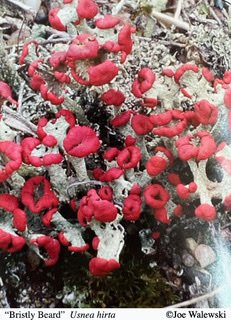By Carolyn Bensinger
For my research paper in the Botanical Art program then at Wellesley, I chose to do a research paper on lichen. Why? It did seem a bit “out there” at the time (not so surprising for me) and especially for me to say “I love lichen.” But when you really start paying attention, really looking at what’s around you, certain things stand out. Lichen stood out for me a long time ago. I first thought they were just beautiful colors and forms found in many locations and did not realize how much there is to learn about lichen. Well yes, of course, that goes pretty much for everything. But lichen?
The idea that lichen might have nourished the Israelites walking across the desert—what? And also the idea that lichen were the first organisms to emerge from the primordial slime millions of years ago? This brings up a question for me—if the primordial slime lichen theory is true, it must be that fungi and algae, separately, must have preceded the lichen, since lichen are formed by these two organisms coming together in a symbiotic relationship.
The New Oxford American Dictionary defines lichen as “a plantlike organism that typically forms a low, crusty, leaflike, or branching growth on rocks, wall, and trees.” They are composite organisms, consisting of photosynthetic green algae or cyanobacteria growing among the filaments of a fungus.
As a jeweler, I am always looking at the ground for something wonderful or at least interesting to inspire me or to include in a piece of jewelry (while also trying not to trip.) Now, I look at flowers, weeds, trees, and leaves for details that are new and thrilling to me. But now, of course, my searches also include lichen.
What struck me as I learned about lichen was the many ways in which lichen are used and how positive their presence is.
In their natural state, lichen help maintain the balance of nutrients on the forest floor; in the far north, in the coldest climates, lichen are food for animals who live there, and are alive under ice and snow.
Lichen help to inform on the quality of the air. In areas where there is lots of pollution, there are no lichen.
In addition, the contributions they have made in their studied and/or manipulated state are many. For centuries, lichen have been the basis of dyes for cloth. Lichen are used in grooming products for hair and for skin remedies. They are being studied for use in anti-HIV treatments.
Lichen come in many colors, sizes, and forms. They are plant-like but not plants. They live among multiple fungi species in a mutualistic relationship, according to Wikipedia. “They many have tiny, leafless branches, flat leaf-like structures, grow crust-like, adhering tightly to a surface like a thick coat of paint, have a powder-like appearance, and many other growth forms.”
So, you see there is no end to what I might discover in lichen to inspire the design of my next pair of earrings, watercolors for my final project, or once I get my certificate, even an abstract painting!
- Photos used from the book Lichens of the North Woods, a North Woods Naturalist Series, with permission by author Joe Walewski
- http://fieldnotesjoewalewski.blogspot.com/search?q=lichens
Here’s an example of my jewelry made with found objects:




